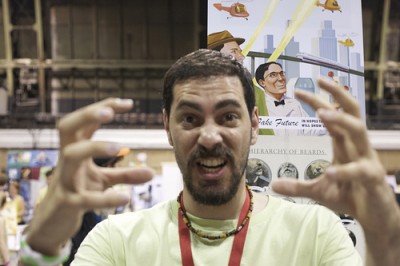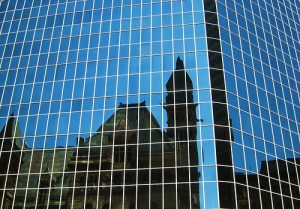Every year, on April 15, I see long lines at the post office as people wait to send in their payment, and similarly at other times of year when corporate taxes and other deadline-specific filings come due. Now, most of these people are certifying or registering their mail, and thus require a visit to the retail counter. But last year I overheard the following exchange just as the post office was closing at 7PM:
CUSTOMER: I need to get this postmarked by today!
EXHAUSTED CLERK: No. We’re closed. You need to go to the main depot [8 miles away], they’re open till 11.
CUSTOMER: It’s already stamped! Can’t you just cancel the stamp for me? It’ll take two seconds!
EXHAUSTED CLERK: Sir, we’re closed. You need to go to the depot.
This was a person who didn’t need the added certainty of registered or certified mail; he just wanted to get his check out before the deadline. All he wanted was a postmark reading April 15.
While this exchange was occurring, I was staring directly at this:
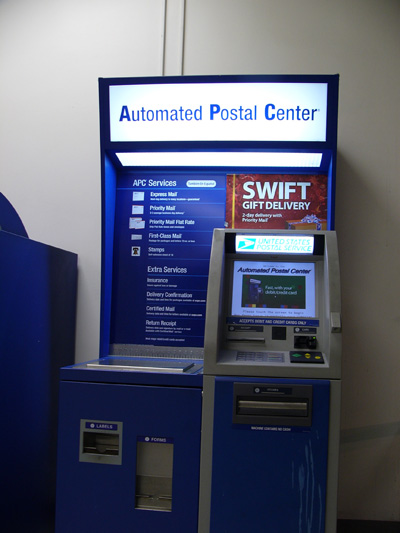
This is the Automated Postal Center. It prints stamps. Stamps with dates on them.
My neighborhood post office has an APC in a 24-hour-accessible lobby. Before I got the Endicia system to print postage at home, I often went to the APC to mail packages in the middle of the night. Any stamp bought before midnight is printed with that day’s date.
One day I realized that all the packages I was mailing weren’t being processed until the following day, and thus their stamps were a full day old. This didn’t seem to be a problem — in fact, now, in the course of my business, I often print stamps on a Friday or Saturday that don’t get mailed until Monday, and I’ve never had any sort of problem.
And then came the day when I realized I hadn’t sent a rent check yet, and it was already the evening of the third — the last postmark day before my landlord charges a late fee. I was out running errands, so I stopped by the post office, printed a stamp from the APC, and took it home. The next morning (the fourth), I mailed the check — the idea being that as far as my landlord knew, it was mailed on time.
Let me repeat this for emphasis: Nobody knew that I hadn’t actually mailed the check on the day I was supposed to. I’ll also clarify that rarely had I ever seen APC stamps, especially on packages, be canceled — so, often, the only date on the envelope would be the date printed on the stamp.
So last April, as I watched the long lines of people wait to mail their taxes, I thought: How many days after April 15 could you still send a tax form with an April 15 stamp? In other words, could you print out an April-15 stamp, go home and finish your taxes, then actually mail the check a week later? Would that work? Or would there be an additional postmark added? Would the letter even arrive?
Let me take time out here for a sanity-check caveat. I am not suggesting that you mail your taxes late, or that this method is in any way reliable or a substitute for doing things correctly. Still, I was curious. So I did the following experiment:
On April 15 of this year, I went to my local APC at 10:30 PM, long after the actual post office had closed. My intent was to buy ten first-class stamps and mail them in succession, seeing how old the stamps would have to be before the letters would start being returned, as well as whether or not they would be canceled with an additional, dated postmark.
The APC has a few purchasing restrictions. One of them is that you can’t make a single purchase for less than a dollar. If you try to buy first-class stamps, it’ll default to a minimum purchase of a dollar rather than let you buy a 44¢ (or, at the time, 42¢) stamp. Anticipating this, I’d brought along a package that needed to be shipped, and bought that (two-dollar-something) stamp first. After that purchase, the APC asked if I’d like to charge something else to the same card, and I said yes. Because I did!
Another restriction is that you can only buy five stamps at a time for the same value. My intent was to buy ten, so I bought two batches of five:
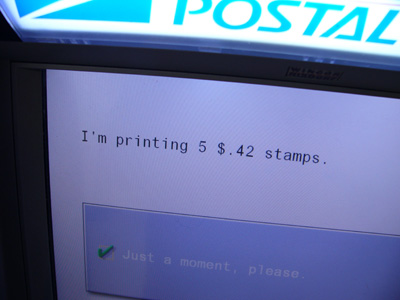
Soon, I had ten first-class stamps, all dated April 15:
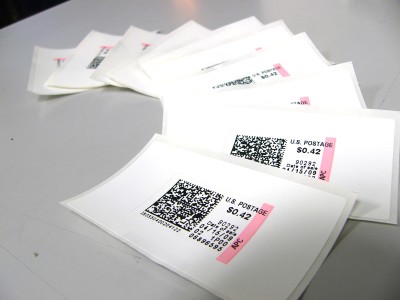
I figured that to really put these stamps to the test, I should send the letters to an address relatively far away — to make sure it went through a lot of depots, verification centers, biometric drug-sniffers, or whatever. I don’t know how this stuff works; I assumed the barcode encoded a lot of crucial information about where the letter came from, where it was going, and how long the stamp should be honored. So I arranged with friends a thousand miles away (in Seattle) to receive the letters, and as a control subject, sent one letter that night of April 15:
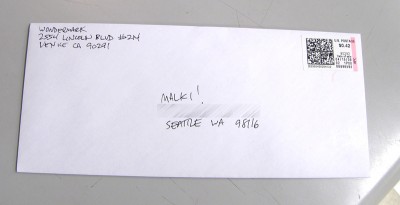
The next letter was sent the next day:
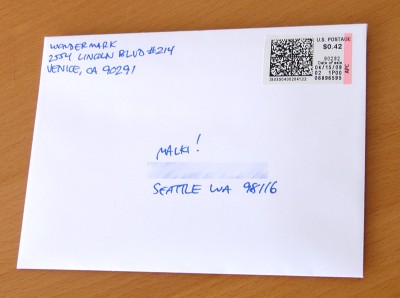
…And so on, at increasing intervals of time, through April 29, a full two weeks after the date of the stamp. I expected that letters sent in the first week or so would arrive, and then they’d start coming back.
I was wrong. They all made it.
Three to five days after each letter was sent from Los Angeles, it arrived in Seattle. I happened to be going to Portland, Oregon during the trial period, so I sent one letter from there; despite the “from a California ZIP code” embedded in the barcode, it made it to Seattle just fine.
Now, perhaps this isn’t so surprising. After all, a stamp is a stamp, and most letters and packages fly through the postal system without anybody second-guessing them. I was clearly wrong about there being a system of CIA-grade laser scanners checking every barcode on every letter for anything awry, but really, that was wishful thinking on my part. I began to tear up my 24 fanfic. Bauer would never follow that last remaining lead now! And the conspiracy threatened to go all the way to the Postmaster General.
The interesting part was that, as predicted, not all of the stamps arrived with cancellations. Of the ten sent to Seattle, only six arrived there canceled — meaning that four envelopes (40%) arrived indicating only the April 15 date and no other postmark.
I had my friend put a new address label on those four envelopes and drop ’em back in the mail — and they all made it back to me in Los Angeles just fine. Now we had letters being sent successfully over a month after the date on the stamp, to say nothing of these stamps having been used twice with no problems. Roughly the same ratio of this second set arrived with cancellations: only two out of the four, or 50%.
Then, in May, the postal rates went up. One-ounce first-class mail increased to 44¢, instead of the 42¢ I had paid. Like the “Forever” stamps, I wondered if the two remaining un-canceled stamps held their value. So two weeks ago, while in San Diego for Comic-Con, I re-mailed the two remaining un-canceled letters, now hoping for a third trip on each stamp. Did they arrive safely? Any guesses?
Of course they did, just a few days later. And again, only 50% (one out of the two — I know it’s hardly statistically significant, but still) arrived canceled. Both were sent in July (a week apart), over three months after the date on the stamp, a hundred miles away from the ZIP code where each stamp was purchased for 2¢ less than the current first-class rate. What is that bar code for, I wonder?
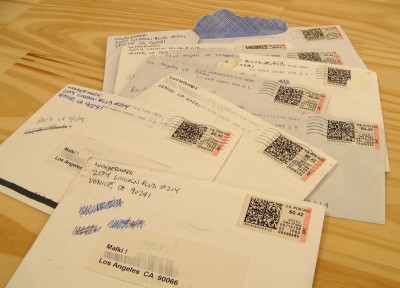
The moral of the story? Perhaps it’s that the Post Office is forgiving. Maybe it’s that those APC stamps last forever. I wouldn’t necessarily use them for time-sensitive stuff like taxes, because you’re definitely playing the odds against having the stamp canceled with an official, dated postmark. But in a pinch, I wouldn’t toss the idea out the window either.
I still have one stamp from April 15 that, as far as I know, is still good. Maybe I’ll keep it safe, and mail myself something every April 15 for years to come until its luck finally runs out and it’s canceled. Or if I don’t, then maybe I can imagine that this is the Lucky Stamp. A hero stamp. Immune. A three-time mail traveler, weathered with toil and still valid besides. How many stamps in history can claim that?
UPDATE: Follow-up!








